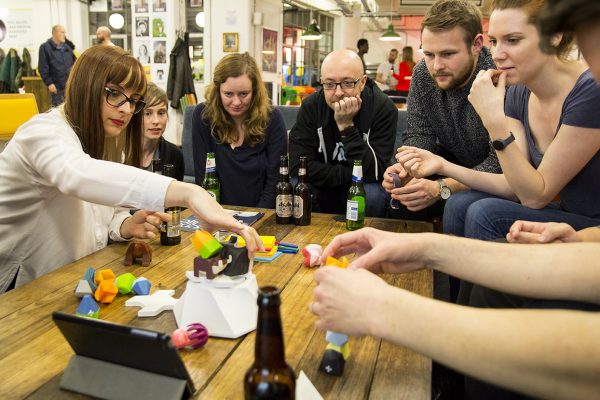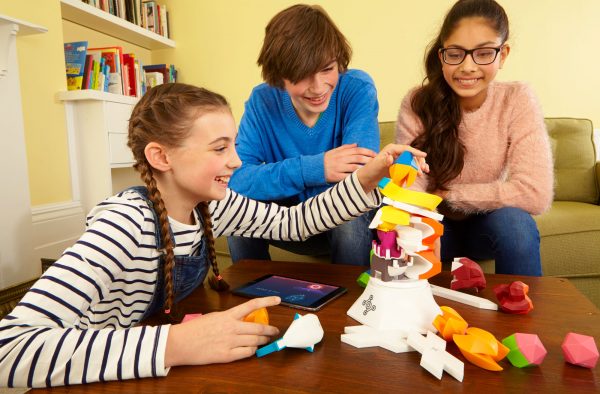Sign-up to our mailing list
Freeing Computer Games from the Screen
For this blog post, we thought we’d do something a bit different. We were lucky to get the acclaimed video game journalist Zoyander Street to interview the production team on how they approached the unique, integrated design challenge of Beasts of Balance. Read on below to see what they said, and what makes Beasts of Balance so unique.
Article Contents
How Sensible Object designs “connected” games that bridge physical and digital worlds
Game developers Sensible Object believe that you can experience the vibrant, magical world of a videogame without just staring at a screen. Their unique projects use connected physical objects to bring fictional worlds out of the screen, through physical things that you can touch. Since launching last year, Beasts of Balance has allowed thousands of people to play in another world by stacking beautiful connected toys in their own homes – and with their next Kickstarter, they’re hoping to make the game even richer.
“With multiplayer games that you play at home, like Mario Kart, you are all looking in the same direction, with controllers in your hands, and you can’t take your eyes off the screen,” says Lead Programmer George Buckenham. “The benefit of a hybrid digital-tabletop game like Beasts of Balance is that you are able to look in each other’s eyes, with hands ready to help catch the blocks as the tower falls.”
Interactive toys have existed for a long time, but it is rare to come across a project like Beasts of Balance, that combines innovative game design with beautiful toys. It’s already challenging to make sure that a game has lots of depth, while making sure it can be played by people of all ages – it takes a really special team to do this while still focusing on the core experience of stacking interestingly shaped objects.
Putting digital games on the table

George is one of only a handful of people in the world who has been making hybrid physical-digital games for years. Before Beasts of Balance, George had made extraordinary games for live events, such as “Punch The Custard” – a game that literally involves punching a bowl of thick, gooey liquid. George was exploring “the idea of having a weird controller”, or “alt controllers”.

“The work I was doing at [games-themed nightclub event] Wild Rumpus is in that space as well… there would almost always be something with a non-traditional controller, or a non-traditional screen.” Hybrid physical-digital games are particularly suited to spaces where a lot of people are curious spectators, while others actually get their hands dirty. “At an an event like that, you are designing things that people will be able to watch as well as participate in.”
Sensible Object isn’t just about making tabletop games more digital – this is a studio where installation art and party planning meets innovative videogame design. The team is an eclectic mix of people who found their voice in London’s remarkable, experimental, and fun creative scenes. Many team members first worked together when creating installations for art galleries, or one-off experiences for big events.
Before Sensible Object, Lead Designer Tim Burrell-Saward spent years creating sculptures and light installations as part of a small but highly celebrated interactive art studio. He says the unusual team composition is a great strength. “We all come from different industries. I had never worked in games before. I look at things in a slightly different way. George and Alex have great knowledge of the indie games community. It gives a different flavour to what we’re making. We argue a lot, but it’s always good.”
In Beasts of Balance, the creative experimentation of live arts events and polished product design are brought together into something that fits onto the dining room tables of people around the world. It’s part of making the kind of experiences that were once limited to people attending a particular event available to a much wider audience. “Normally you’re constrained by the fact that this is an event, it’s a one-off,” says George. “Beasts of Balance has given us an opportunity to make something that lives in someone’s home.”

Using what they’ve learned from designing for real-world events, Sensible Object have been able to make Beasts of Balance more than just a fun tablet game with some toys attached. “It’s a context to hanging out and having a social interaction,” says George. But skilful game design has also been essential.
It’s taken a lot of hard work, and trial and error, to make Beasts of Balance simple to understand but also rich with depth. At one point in its early development the game had almost 50 pieces, and although it was fun for those who understood it, feedback from players showed that it was too complicated. The designers had to strip the whole thing back and start again in order to make Beasts of Balance the streamlined game it is today.

“I’ve been surprised by how well this works. There haven’t been a lot of games like this before,” reflects Lead Artist Lyall McCarthy, whose background is in illustration and UI for mobile and tablet games. This is his first project involving physical objects aside from the user’s digital device. “The concept of physical and digital is something I hadn’t thought of before this project… It was a nice surprise that people took to it so enthusiastically.”
As a user interface designer, Lyall is used to thinking about players and understanding their needs. Beasts of Balance is a game that has enough depth that it plays a bit differently every time, and everybody plays it their own way. This makes playtesting a lot of fun. “You always see something new in how people play. Something you’d never even considered comes out,” says Lyall. “We play the game a lot in the studio, but someone at an event might hang one piece off another in a way that we never thought of.” Bringing games back into the physical world makes them more interactive, and makes play into a creative, collaborative act.
One thing that surprised Lyall about how people play Beasts of Balance was finding that there are a lot of people who want to suss out the system and plan ahead before taking any action whereas his own approach to play is a lot more exploratory, trying something out to see what happens. Sensible Object are building expansions that are designed to appeal to those players, giving them more ways to strategize and more depth to uncover as they learn the game’s systems.
Designing digital and physical characters
While Lyall is in charge of how things look on the screen of your phone or tablet, it’s Tim who is responsible for making sure the games physical pieces or Artefacts are beautiful objects that also stack well. This is not as simple as just taking a 3D model of a character and sending it to a 3D printer. Physical manufacturing is a delicate operation at the best of times, and the developers had to come up with a good system that allows us to design toys that stack well. “There are constraints that have to be followed for every physical thing that exists in the world,” says Tim. “You have to be careful with every line and curve.”
Lyall and Tim have been working together to make sure the physical beasts and their onscreen counterparts feel closely related to one another. “Initially when I was designing the world, the colour scheme was a desert orange, but feedback from play testing told us that the physical artefact colours didn’t correspond to what was on screen. I brought my colour scheme in line with the blocks, and the blocks were tweaked as well to compromise.”
Lyall cares about consistency. “I want things to feel cohesive, all under the same umbrella.”
One of the main design challenges that Lyall has had to overcome when creating the characters for Beasts of Balance was making sure that everything would make some sort of sense when animals’ body parts have recombined. In early versions of the game, he used a kind of origami aesthetic so that they could slot together along similar geometric lines. It looked cool, but it lacked that cute relatability of the beast designs that the game has now. The solution he came up with in the end was having a main body with animated parts attached to it.
The new beasts that they are introducing in the expansion have been an opportunity for Lyall and Tim to take the systems they’ve already created and push them further. “I’ve designed them to open up more interesting ways they could be played, like there’s one beast that has a kind of cantilevering,” says Tim. “These should open up a lot of new possibilities when used in conjunction with the other pieces, making the set as a whole more fun.”
This is a game where the physical objects in front of you are not just props or controllers – they are an essential part of the gameplay itself. Whereas party games such as Wii Sports require that everyone learn how to manipulate an abstract controller, with Beasts of Balance there is a common frame of reference that everybody automatically understands – a tower of beasts and other artefacts that threatens to fall. As the game becomes more complex with each expansion, the beasts themselves are going to become more and more intriguing, in both their physical and on-screen forms.
Lyall’s dedication to consistency means paying close attention to detail when adding new characters: “We’ve designed them to be in-line with how the other beasts work: the system is the same, they have the same size bodies and we’re making sure the other parts are the right size and shape too, with no conflicts between body parts. For example, making sure the chameleon tail won’t be obscured by the legs on a bear. The new beasts bring in new variety, new colours, and new, interesting hybrids.”
Gaming for kids and grown-ups together
A beautiful thing about Beasts of Balance is that it naturally scales up and down to meet the skill level of the players. That means you can add an expansion pack and still preserve the game’s interest for all ages. After all, what could be more understandable to a kid than a game about stacking things?

The scalability of play styles applies even to the design of the blocks themselves. “You have to design for the manual dexterity of an 7 year old as well as a 30 year old”, says Tim. “Next time you play any dexterity game, pay attention to the level of difficulty. It is very difficult to balance.”
Balancing a videogame or tabletop game happens through trial and error. Tim says that early in the design process, the block-stacking aspect of Beasts of Balance was too easy. “Then we adjusted, and it became too hard, now we think it’s just right.”
George is particularly pleased with the experience of stacking: “I’m proud that the game always works. If you put a piece on the pedestal, it’s never going to say “oh that didn’t work” or “you did it wrong”, it will always respond somehow. When a younger child picks it up, it degrades very gracefully into a toy that makes nice noises.”
With the expansion pack, the game takes on a new level of depth, as well as adding gorgeous new beasts such as anglerfish, flamingo and chameleon. That means more cute beasts, more ways to stack them, and more unique hybrid creatures to discover. As well as increasing the competitive elements for people who want to be the best, Sensible Object are also expanding the bestiary for players who want to collect all the different beasts in the game.
Just like the towers of beasts that are created during play, the expansion rests on a solid foundation of great design, built from years of experience making games, art, and social experiences. Sensible Object has a fast-growing team with heaps of experience in game development, product design, and user interface design, who are hard at work making these experiences richer and deeper.
If you enjoyed learning about the process that went into making Beasts of Balance, make sure to share this post on Facebook, Twitter, or LinkedIn.


